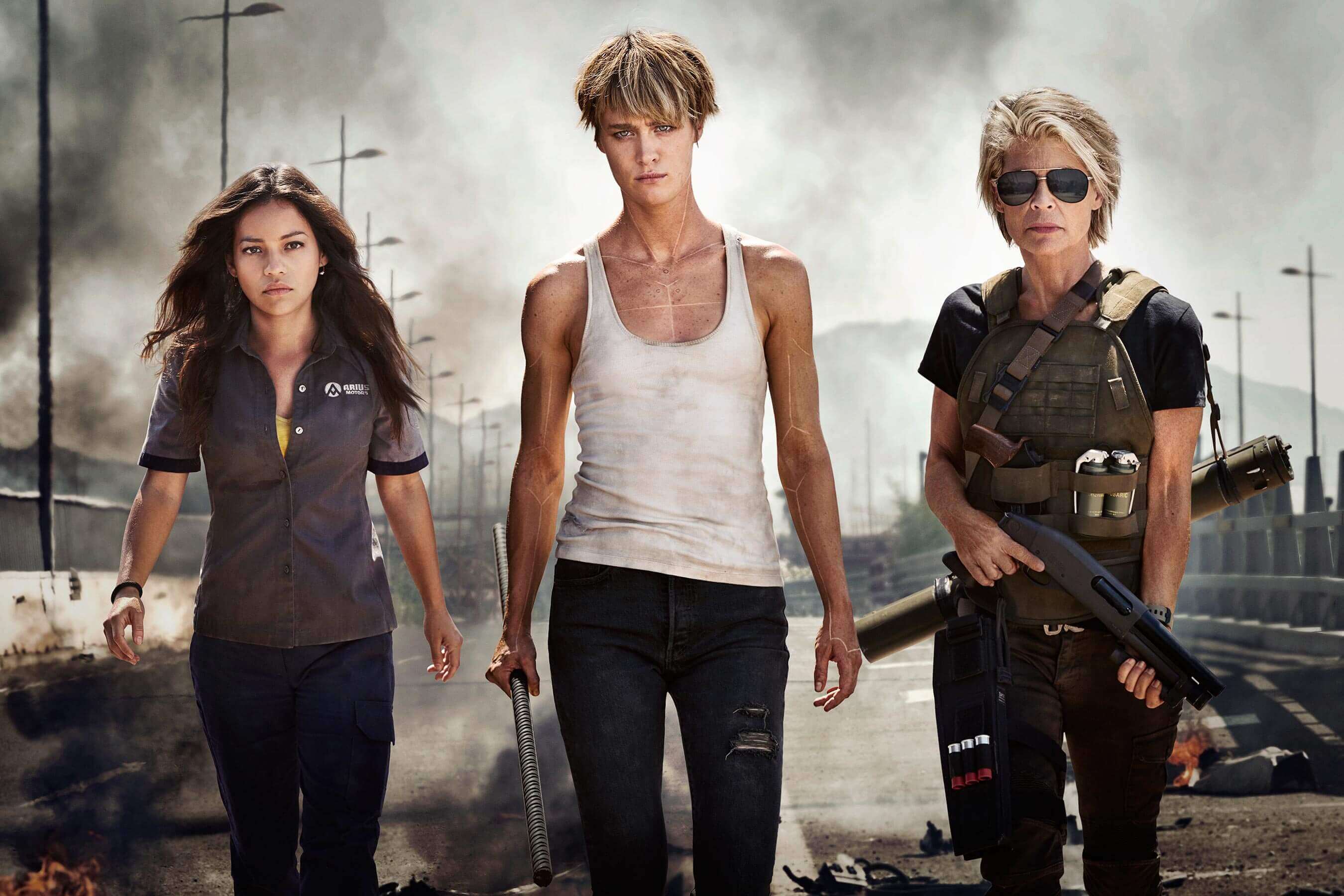 ★★½
★★½
“She’ll not be back”
If you went back in time, and told James Cameron on the set of the original Terminator, that 35 years later, it would have spawned six movies and a TV series, he probably wouldn’t have believed you. It’s not a story which screams “Franchise,” being entirely self-contained. The first sequel justified itself with a sea-change in digital effects which marked a massive shift in the way popular cinema would work thereafter. Everything beyond that? Almost entirely superfluous. And I speak as someone who liked Terminator 3: Rise of the Machines considerably more than most people.
I can certainly see why this flopped though. It comes on the heels of Salvation and Genesys, both of which were commercially dubious and critically disastrous, to the point that Cameron decreed them to have happened in alternate universes, effectively retconning them out of existence. This set Dark Fate up as a direct sequel to the franchise’s most successful installment, which also happens to be one of the greatest action films of all time (it’s likely in my top five, and not the only James Cameron film there either). Comparisons were never going to be kind to Dark Fate.
Then, Miller opens his film with footage from T2, in which an amazingly intense Sarah Connor describes her vision of Judgment Day. Rather than trying to build the movie’s own universe, the audience is immediately reminded of just how damn good its predecessor was. I turned to Chris and whispered, “We really must watch T2 again.” This is not something you should be thinking, thirty seconds into a sequel. It’s just the first in a number of missteps which end up burying the franchise once again, rather than resurrecting it.
The main problem is, we’ve seen it all before. The story is basically the same as Terminator. Or Terminator 2. Or Terminator 3. Robot gets sent back in time by future self-aware AI to kill a human it deems is a threat. Pro-mankind asset gets sent back in time to protect the target. They fight. A lot. There are a couple of wrinkles here. The protector (Davis) is actually an “augmented” human herself, albeit still short of the levels of her enemy (Luna). And Dani Ramos (Reyes) isn’t the mother of someone who’ll save humanity. But it feels less a sequel than a reboot, as we still have to watch Dani going through the whole explanatory process and “Five stages of being a Terminator target” thing.
Probably the main hook, however, is the presence of both Hamilton and Arnold Schwarzenegger, re-united for the first time since T2. Cue another misstep: if their appearances had been unexpected twists, they would both have come as delightful surprises. And the way they are filmed, makes it feel like that may have been the original intent. For instance, when Sarah Connor makes her entrance, we see her feet getting out of the car, the mysterious saviour only eventually revealed. The same is true when the T-800 arrives. Except those bullets were already fired by marketing, with them both showing up, full face, in the trailers. And it’s never explained why a 100% artificial creature like the T-800 has aged 35 years, nor how it’s getting the information with which it helps Sarah.
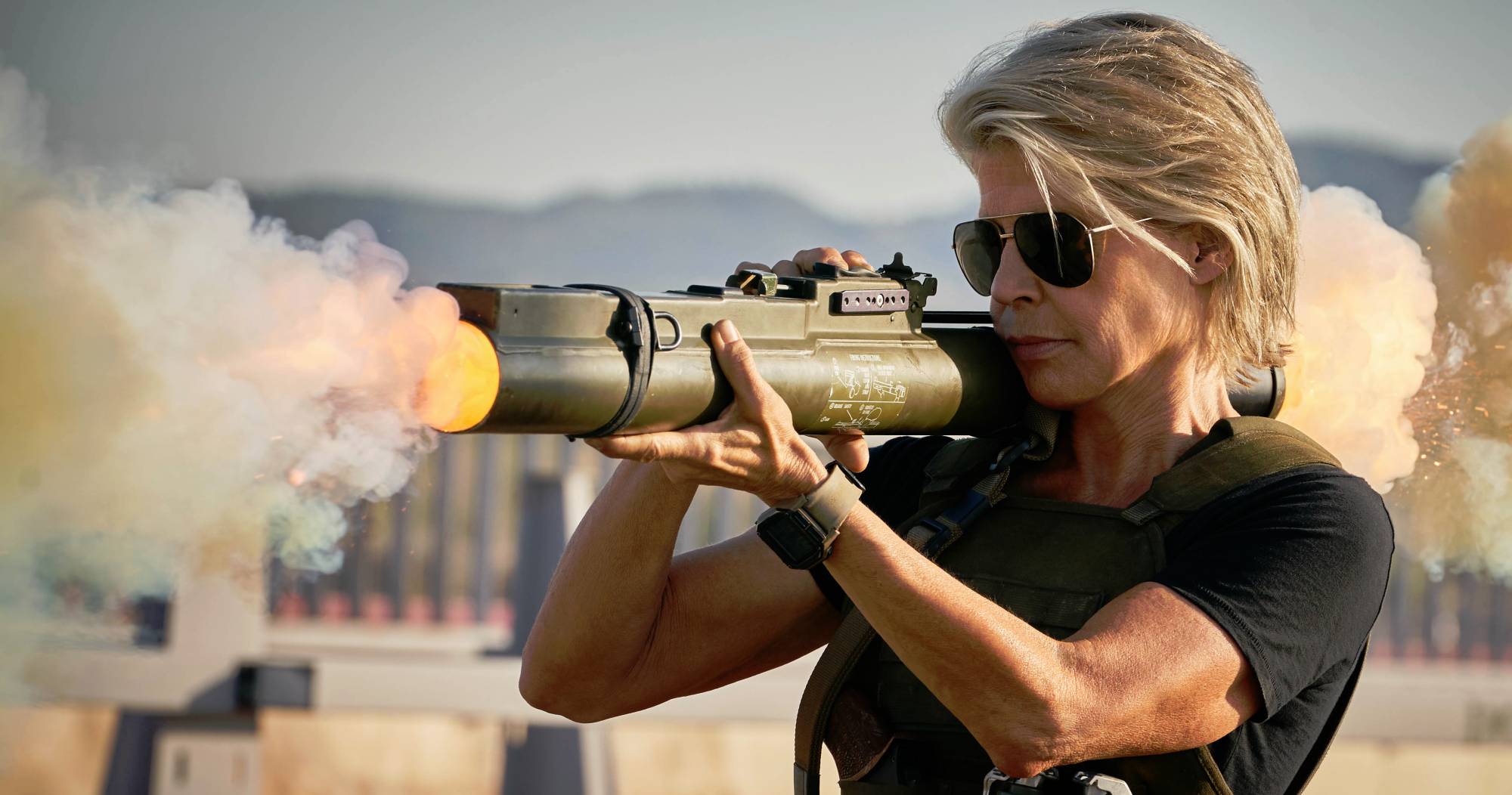
The familiarity of the plot would be bearable, if the execution was up to much. After all, T2 recycled its plot to a not dissimilar degree. However, it pushed the spectacle to 11, and was superior to the original as a result. This… Did not. Indeed, I was shocked by how ropey much of the CGI and digital work was, for a $190 million budget. Not so much the new Rev-9 model Terminator, which is a slick, oily creation like an intelligent pool of tar. But the meshing with the actors is poor, especially when one or other is made to fly through the air.
Maybe this kind of thing works in superhero films like Miller’s Deadpool. Here, it falls well short of the physical impact we saw in T2, or even T3, where the bathroom brawl felt like it had a bone-crunching realism to it. The low-point here is a battle on a plummeting plane, which is so poorly shot, edited and even lit as to be entirely incoherent. You literally have no idea which was is up, and I was simply left waiting for it to be over, and figure out what happened based on who walks away from the wreckage. [Spoiler: it’s everyone]
The entry isn’t entirely without merit though. While Dani is no Sarah Connor v2.0 (and her brother is worse still, quickly triggering a Chris whisper to me, “I hope he dies soon…”), Sarah 1.0 has a tired cynicism which is endearing and understandable. Maybe if they’d made the film entirely about Connor, spending her life going from place to place, hunting and destroying Terminators? There could then have been a whole slew of styles of opponent, making it the Godzilla: Final Wars entry in the franchise. Arnie, too, possesses a charisma which is mostly notable by its absence from the rest of the cast, though Davis makes a better impression than I feared.
There’s also a brilliant sequence set thirty years ago, depicting a young Sarah and John Connor, which is so well done, I was left wondering if this was unused footage from T2. Again, I’m left to wonder if they should have embraced that wholeheartedly and had the entire film take place in that era. We might then have avoided the SJW beats e.g. Border Patrol = bad, though at least these are relatively light compared to some recent Hollywood product. Well, save the clumsy way Dani becomes the future messiah, which triggered derisive snorting from my direction.
It would be a stretch to say we were storming the box-office, demanding a refund. We don’t see many films at the cinema, and despite my criticisms, this did not feel like we wasted our time or our money. It does deliver, as a cinematic spectacle, and is certainly an improvement over Salvation and Genesys, both of which triggered actual sleep. Yet I was reminded of a definition of insanity: repeating the same actions, over and over, hoping for a different result. It appears making Terminator sequels potentially qualifies.
Dir: Tim Miller
Star: Natalia Reyes, Mackenzie Davis, Linda Hamilton, Gabriel Luna
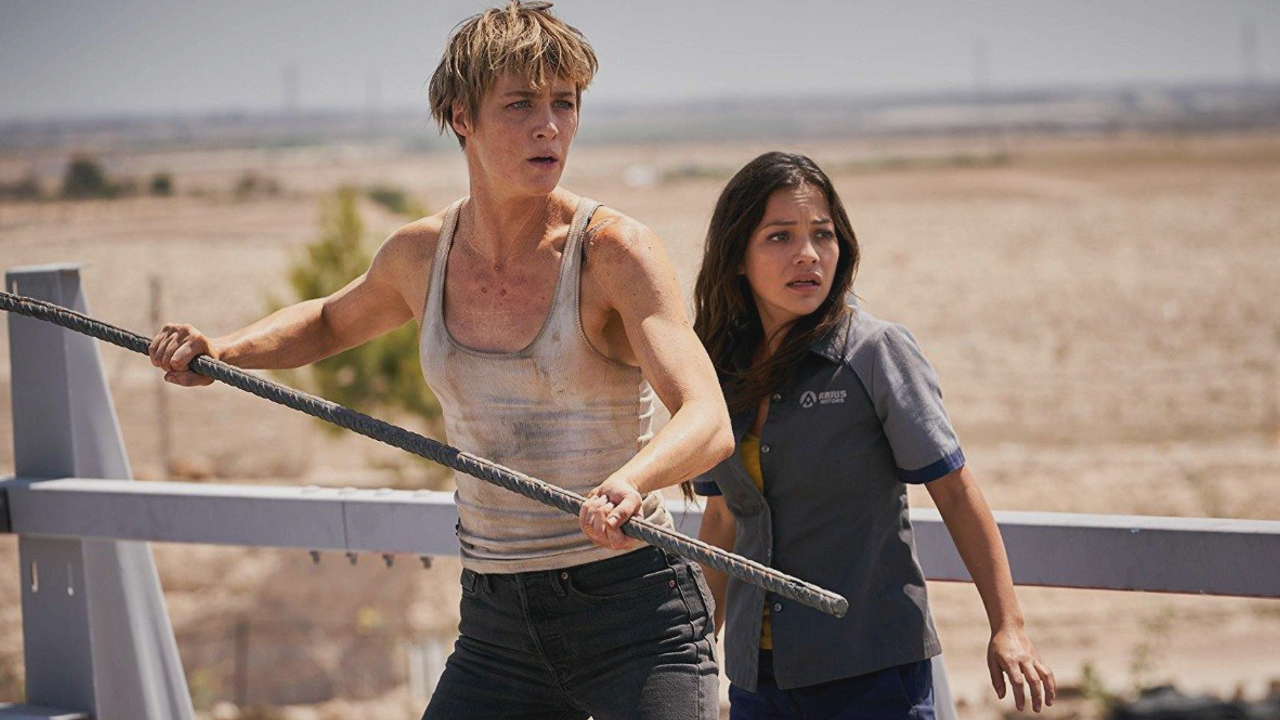
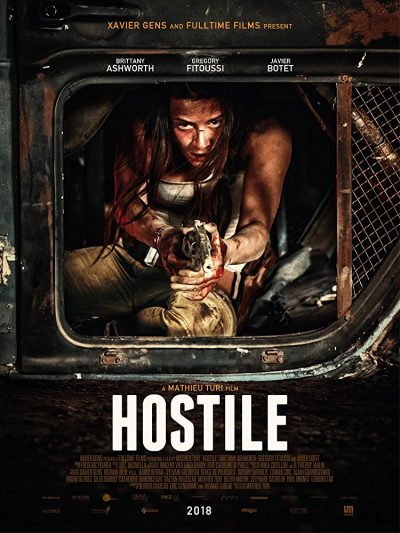 After an un-specified global apocalypse, humanity is reduced to small bands of scattered survivors, who have to try and scratch out survival, while avoiding the attacks of “reapers”, mutated creatures which stalk the landscape, especially after dark. One of those survivors is Juliette (Ashworth), who is on a foraging mission in the desert when an accident throws her off the road, and leaves her with a badly-broken leg. She has to wait for help to arrive, fending off the reaper (Botet) which is prowling the area, with whatever she can find to hand. As she does so, she thinks about life before the apocalypse, where she escaped drug addiction with the help of her boyfriend, gallery owner Jack (Fitoussi) – only for happiness to be fleeting, and taken away from her when multiple tragedies strike.
After an un-specified global apocalypse, humanity is reduced to small bands of scattered survivors, who have to try and scratch out survival, while avoiding the attacks of “reapers”, mutated creatures which stalk the landscape, especially after dark. One of those survivors is Juliette (Ashworth), who is on a foraging mission in the desert when an accident throws her off the road, and leaves her with a badly-broken leg. She has to wait for help to arrive, fending off the reaper (Botet) which is prowling the area, with whatever she can find to hand. As she does so, she thinks about life before the apocalypse, where she escaped drug addiction with the help of her boyfriend, gallery owner Jack (Fitoussi) – only for happiness to be fleeting, and taken away from her when multiple tragedies strike.




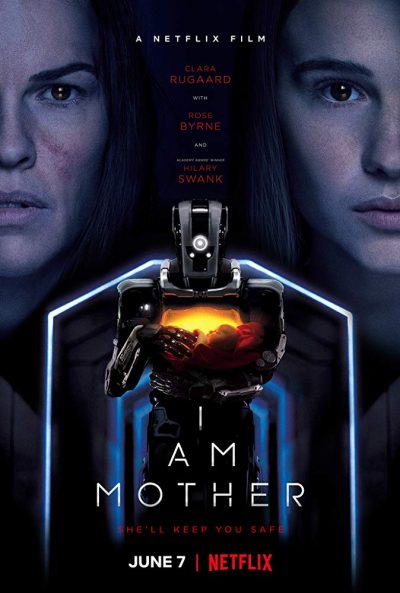 After an extinction-event has turned Earth uninhabitable, an underground “ark” holds thousands of human embryos, overseen by a robotic Mother (voiced by Byrne, performed by Hawker). One embryo is brought to fruition, becoming Daughter (Rugaard, resembling a young Jennifer Garner), who grows up into a young woman, educated by Mother to believe she’s alone on the planet. But she begins to doubt what Mother tells her, and these doubts are confirmed when another, older woman (Swank) shows up. Let in by Daughter, she tells tales of humanity outside struggling for survival against robot killers. Everything Daughter has been told is a lie. Or is the new arrival telling the whole truth either?
After an extinction-event has turned Earth uninhabitable, an underground “ark” holds thousands of human embryos, overseen by a robotic Mother (voiced by Byrne, performed by Hawker). One embryo is brought to fruition, becoming Daughter (Rugaard, resembling a young Jennifer Garner), who grows up into a young woman, educated by Mother to believe she’s alone on the planet. But she begins to doubt what Mother tells her, and these doubts are confirmed when another, older woman (Swank) shows up. Let in by Daughter, she tells tales of humanity outside struggling for survival against robot killers. Everything Daughter has been told is a lie. Or is the new arrival telling the whole truth either? Despite a mangled title, what you have here is a straightforward tale of vengeance – and its attempts to diverge from that narrative are when the film is at its least interesting. Evil general Ji Xian Tang kills the parents of Ho Yu Fung (Ding): well, I suppose technically he only kills her father, her mother committing suicide by the corpse. In some remarkably unsubtle foreshadowing, Yu Fung is told, “This broadsword is our family heirloom. Our hope for vengeance is in your hands.” Given this, it’s no surprise she escapes with the help of a brave sacrifice from a servant, and becomes the pupil of a kung-fu master.
Despite a mangled title, what you have here is a straightforward tale of vengeance – and its attempts to diverge from that narrative are when the film is at its least interesting. Evil general Ji Xian Tang kills the parents of Ho Yu Fung (Ding): well, I suppose technically he only kills her father, her mother committing suicide by the corpse. In some remarkably unsubtle foreshadowing, Yu Fung is told, “This broadsword is our family heirloom. Our hope for vengeance is in your hands.” Given this, it’s no surprise she escapes with the help of a brave sacrifice from a servant, and becomes the pupil of a kung-fu master. Some years ago, my Goodreads friend Mary J.L. gave the original novel of the author’s Nadia Stafford trilogy a favorable review, and that put it on my radar. As a rule, I don’t read novels that are only published in electronic format (it does have a audio version, but I don’t listen to audio books either), but I do read short e-stories; electronic publishing provides a forum for those works which no longer exists in print, what with the demise of general-circulation magazines. This tale, as a novella, occupies a middle ground, but commercially novellas are in much the same boat as short stories –a single one wouldn’t sell very well in print format. So I felt it was fair to treat it the same way, and thought it would be a good way to check out the series for myself.
Some years ago, my Goodreads friend Mary J.L. gave the original novel of the author’s Nadia Stafford trilogy a favorable review, and that put it on my radar. As a rule, I don’t read novels that are only published in electronic format (it does have a audio version, but I don’t listen to audio books either), but I do read short e-stories; electronic publishing provides a forum for those works which no longer exists in print, what with the demise of general-circulation magazines. This tale, as a novella, occupies a middle ground, but commercially novellas are in much the same boat as short stories –a single one wouldn’t sell very well in print format. So I felt it was fair to treat it the same way, and thought it would be a good way to check out the series for myself.
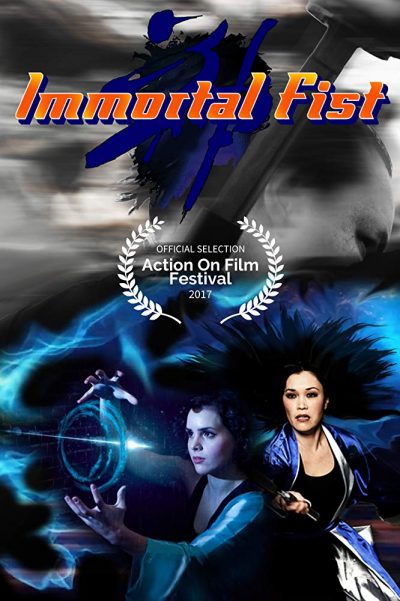 The above quote does suggest that the makers here appreciate how ridiculous the entire thing is. And that self-awareness may be the main thing which saves this from being largely cringeworthy. Just because you
The above quote does suggest that the makers here appreciate how ridiculous the entire thing is. And that self-awareness may be the main thing which saves this from being largely cringeworthy. Just because you  It’s the summer of 1942, and Soviet forces are facing the invading German Army. After Sergeant Major Vaskov (Martynov) requests soldiers for his anti-aircraft battalion who won’t get drunk and molest the local women, he gets what he wants. Except, the new arrivals are an all-female squad of soldiers, with whom Vaskov is initially singularly ill-equipped to deal. However, they prove their mettle, led by the efforts of Rita Osyanina (Shevchuk), and eventually win Vaskov’s respect. While returning to the barracks one night, Rita stumbles across two Nazi paratroopers; she, along with four colleagues and Vaskov, form a search party, and head deep into the surrounding forest to capture the Germans. However, they discover the real force is significantly bigger, and must begin a guerilla warfare campaign to disrupt the enemy’s mission, harrying them through the wooded and marshy terrain.
It’s the summer of 1942, and Soviet forces are facing the invading German Army. After Sergeant Major Vaskov (Martynov) requests soldiers for his anti-aircraft battalion who won’t get drunk and molest the local women, he gets what he wants. Except, the new arrivals are an all-female squad of soldiers, with whom Vaskov is initially singularly ill-equipped to deal. However, they prove their mettle, led by the efforts of Rita Osyanina (Shevchuk), and eventually win Vaskov’s respect. While returning to the barracks one night, Rita stumbles across two Nazi paratroopers; she, along with four colleagues and Vaskov, form a search party, and head deep into the surrounding forest to capture the Germans. However, they discover the real force is significantly bigger, and must begin a guerilla warfare campaign to disrupt the enemy’s mission, harrying them through the wooded and marshy terrain. ★★½
★★½

 Either by intent or accidentally – and we’ll get to that in a moment – this manages to be both an indictment of and an advert for, American gun culture. That’s quite a spectacular achievement, and it’s perhaps no coincidence that the writer/director is British, so brings an outsider’s balanced eye to a topic that’s often acrimonious in the States. Kathleen Sullivan (Young) is a teacher who has just moved from Boston to a small Texas town. She falls for local attorney Larry Keeler (Day), though is only interested in friendship, not a significant relationship. The initially-charming Larry eventually won’t take no for an answer, and date-rapes Kathleen. However, the circumstances and her attacker’s local reputation mean she gets no satisfaction from the police. The meek and mild Kathleen decides to take matters into her own hands, buying a gun and taking up combat shooting – at the very same club Larry frequents – with the aim of meting out her own brand of justice.
Either by intent or accidentally – and we’ll get to that in a moment – this manages to be both an indictment of and an advert for, American gun culture. That’s quite a spectacular achievement, and it’s perhaps no coincidence that the writer/director is British, so brings an outsider’s balanced eye to a topic that’s often acrimonious in the States. Kathleen Sullivan (Young) is a teacher who has just moved from Boston to a small Texas town. She falls for local attorney Larry Keeler (Day), though is only interested in friendship, not a significant relationship. The initially-charming Larry eventually won’t take no for an answer, and date-rapes Kathleen. However, the circumstances and her attacker’s local reputation mean she gets no satisfaction from the police. The meek and mild Kathleen decides to take matters into her own hands, buying a gun and taking up combat shooting – at the very same club Larry frequents – with the aim of meting out her own brand of justice. I was initially a bit concerned this was going to be a slightly-more horror oriented version of Harry Potter, based largely off the title. I needn’t have been worried. For at least the first two books, this is quite startlingly dark and on the razor’s edge. As for the third… well, we’ll get to it. The setting here is a world where Filipino shapeshifters called aswangs, which feed on the fear of their victims, are migrating across from their home country and through Alaska. Lined up to stop them, by any means necessary, are hunters; it’s a harsh and often brief occupation. To replace those lost in battle, the titular establishment exists on Kodiak Island, to train hunters – mostly members of families who have been in the bloody business for generations.
I was initially a bit concerned this was going to be a slightly-more horror oriented version of Harry Potter, based largely off the title. I needn’t have been worried. For at least the first two books, this is quite startlingly dark and on the razor’s edge. As for the third… well, we’ll get to it. The setting here is a world where Filipino shapeshifters called aswangs, which feed on the fear of their victims, are migrating across from their home country and through Alaska. Lined up to stop them, by any means necessary, are hunters; it’s a harsh and often brief occupation. To replace those lost in battle, the titular establishment exists on Kodiak Island, to train hunters – mostly members of families who have been in the bloody business for generations.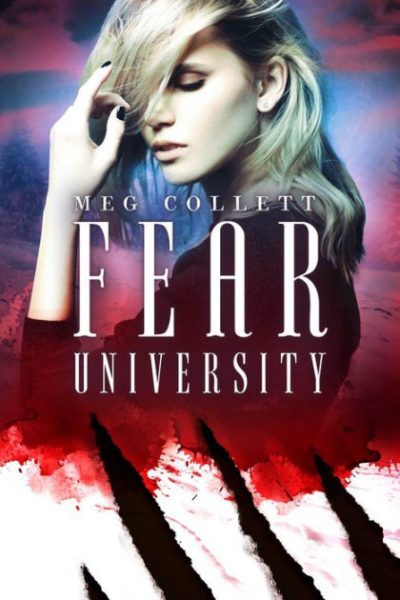 Those opening two books keep the story going forward. In the first volume, Fear University, she learns to tap into the power her talent gives her; builds a relationship with the similarly-broken young hunter Luke, who is her mentor; discovers aswang saliva can make her feel pain; finds out who her father was; and has to go through a life-or-death test involving both her, and her best friend at FU, Sunny. The second, Killing Season, is a rather drastic change in approach, with Ollie, Luke and others sent north to Barrow for the winter break, when the aswang are most active. That was the location used for vampire action film 30 Days of Night, and serves the same kind of purpose here. However, it’s almost as much a whodunnit, with the large house which is the hunters’ base apparently home to a killer. Not helping matters: Max shows up in town.
Those opening two books keep the story going forward. In the first volume, Fear University, she learns to tap into the power her talent gives her; builds a relationship with the similarly-broken young hunter Luke, who is her mentor; discovers aswang saliva can make her feel pain; finds out who her father was; and has to go through a life-or-death test involving both her, and her best friend at FU, Sunny. The second, Killing Season, is a rather drastic change in approach, with Ollie, Luke and others sent north to Barrow for the winter break, when the aswang are most active. That was the location used for vampire action film 30 Days of Night, and serves the same kind of purpose here. However, it’s almost as much a whodunnit, with the large house which is the hunters’ base apparently home to a killer. Not helping matters: Max shows up in town.